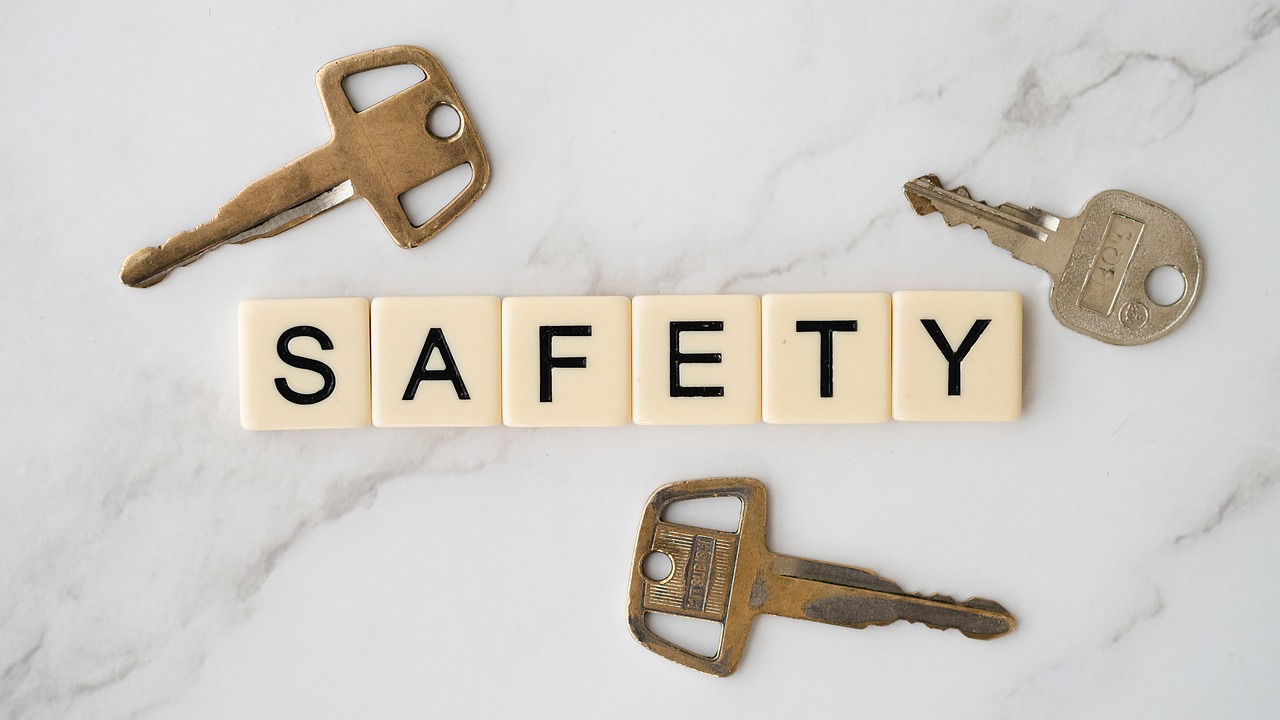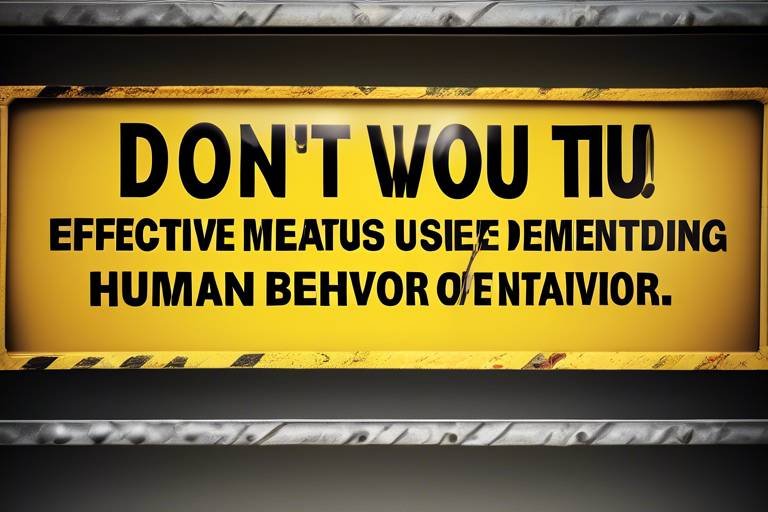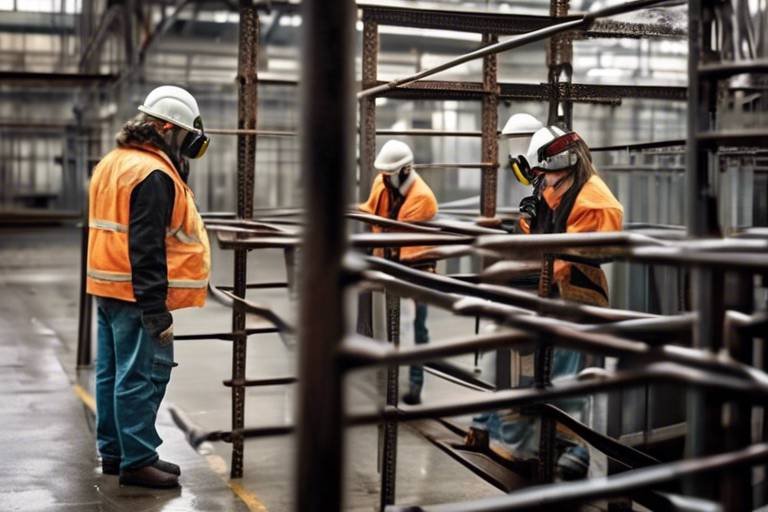Why Understand Human Behavior for Safety Compliance?
In today's fast-paced work environments, the **intersection of human behavior and safety compliance** is more critical than ever. Have you ever wondered why some employees strictly adhere to safety protocols while others seem to ignore them? This discrepancy often stems from underlying psychological factors that influence how individuals perceive and respond to safety measures. Understanding these factors is not just beneficial; it’s essential for creating a workplace where safety is prioritized and ingrained in the culture.
When we talk about safety compliance, we’re not just discussing rules and regulations; we’re delving into the **mindset of employees**. Every day, workers face decisions that can impact their safety and the safety of their colleagues. By understanding the **psychological principles** that drive these decisions, organizations can tailor their safety strategies to better influence employee behavior. This approach fosters a culture where safety is not merely a checkbox but a core value shared by everyone in the organization.
Moreover, understanding human behavior allows organizations to identify the **barriers that hinder compliance**. For instance, fear of reprimand, lack of understanding, or even complacency can prevent employees from following safety protocols. By addressing these barriers head-on, organizations can develop targeted interventions that resonate with employees, ultimately leading to enhanced safety compliance. This is where the magic happens—when employees feel understood and supported, they are more likely to engage in safe practices.
Additionally, the relationship between human behavior and safety compliance extends beyond mere adherence to rules. It encompasses the creation of an environment where employees feel empowered to speak up about safety concerns. When workers know that their voices matter, they become active participants in the safety culture rather than passive observers. This kind of engagement not only improves compliance rates but also fosters a sense of **community** and **shared responsibility** among employees.
In summary, the journey toward effective safety compliance begins with a deep understanding of human behavior. By recognizing the psychological factors at play, organizations can create an environment that not only encourages compliance but also inspires employees to take ownership of their safety and the safety of those around them. So, the next time you consider safety compliance, remember: it’s not just about the rules; it’s about the people behind them.
- Why is understanding human behavior important for safety compliance?
Understanding human behavior helps organizations tailor their safety strategies, addressing psychological barriers and fostering a culture of safety. - What are some common barriers to safety compliance?
Common barriers include fear of repercussions, lack of understanding, and complacency among employees. - How can organizations improve safety compliance?
By implementing effective training programs, creating a supportive environment, and utilizing technology to enhance communication and monitoring. - What role does communication play in safety compliance?
Clear communication ensures employees understand safety policies and their responsibilities, promoting adherence to safety protocols.

The Psychology of Safety Compliance
Understanding the psychological principles behind safety compliance is crucial for organizations aiming to create a safer workplace. Why? Because human behavior is often the biggest factor in whether safety protocols are followed or ignored. When we delve into the minds of employees, we find a complex web of emotions, beliefs, and perceptions that influence their actions. It’s not just about rules and regulations; it’s about how people feel and think about those rules.
For instance, many employees may view safety protocols as just another set of guidelines to follow, often overlooking their significance. This can lead to a lack of engagement with the safety culture within the organization. To combat this, it’s essential to foster an environment where safety is seen as a shared responsibility rather than a chore. By leveraging psychological insights, organizations can tailor their strategies to enhance compliance and cultivate a culture of safety.
One of the key psychological factors is the concept of cognitive dissonance. When employees are aware of safety protocols but choose to ignore them, they may experience discomfort because their actions do not align with their knowledge. This dissonance can lead to a change in behavior if addressed correctly. For example, if employees are reminded of the potential consequences of ignoring safety measures, they may be more inclined to adhere to them. This highlights the need for effective communication strategies that resonate with employees on a personal level.
Additionally, understanding the role of emotional responses in safety compliance is vital. Fear of accidents or injuries can either motivate employees to follow safety protocols or paralyze them into inaction. This is where the importance of emotional intelligence in management comes into play. Leaders must not only communicate the importance of safety but also understand the emotional landscape of their teams. By creating an environment that encourages open discussions about fears and concerns, organizations can address these emotional barriers head-on.
Furthermore, the concept of social proof can significantly influence safety compliance. When employees see their peers actively engaging in safe practices, they are more likely to follow suit. This is why it's essential to highlight safe behaviors through recognition programs or by sharing success stories within the organization. By showcasing positive examples, organizations can create a ripple effect, encouraging others to adopt similar behaviors.
In summary, understanding the psychology of safety compliance is not just about implementing rules; it’s about understanding the people behind those rules. By addressing emotional factors, fostering a supportive environment, and leveraging social influences, organizations can effectively enhance safety compliance and cultivate a culture of safety that resonates with every employee. After all, a safe workplace is not just a goal; it’s a collective mindset.

Common Behavioral Barriers to Compliance
When it comes to safety compliance, understanding the human element is crucial. Often, organizations find themselves grappling with behavioral barriers that hinder adherence to safety protocols. These barriers can stem from a variety of factors, including psychological, social, and environmental influences. By recognizing these barriers, companies can develop targeted interventions that not only address the root causes but also enhance overall compliance rates. So, what are these common behavioral barriers? Let’s dive in!
One major barrier is fear. Fear can manifest in different forms—fear of reprimand, fear of job loss, or even fear of being perceived as incompetent. Employees may choose to ignore safety protocols simply because they don’t want to draw attention to themselves. Imagine a worker who notices a safety hazard but decides to stay silent because they fear that reporting it might lead to blame or punishment. This fear can create a culture where employees feel they must choose between safety and job security, leading to dangerous outcomes.
Another significant barrier is risk perception. Employees often assess risks based on their personal experiences and beliefs. If they believe that a certain task is low-risk, they may disregard safety measures altogether. This is where the importance of training and education comes into play. By reshaping how employees perceive risks through effective training, organizations can empower their workforce to make safer choices. For instance, a construction worker might underestimate the dangers of working at heights until they undergo a training session that highlights the potential consequences of a fall.
Additionally, the workplace environment itself can either encourage or discourage safety compliance. A supportive environment fosters open communication about safety concerns, while a toxic atmosphere can lead to employees feeling uncomfortable discussing risks. When employees feel that they can’t voice their concerns without facing backlash, compliance takes a backseat. It’s essential for organizations to cultivate a culture where safety is prioritized and employees feel safe to speak up.
Lastly, let’s not overlook the role of motivation and incentives. Many employees are driven by rewards, and when compliance is not linked to any tangible benefits, it can lead to a lack of motivation. Organizations that implement incentive programs—such as recognizing employees for adhering to safety protocols—often see improved compliance rates. For example, a company that offers monthly safety awards can create a friendly competition among workers, encouraging them to prioritize safety in their daily tasks.
In summary, understanding the common behavioral barriers to compliance is essential for organizations aiming to foster a culture of safety. By addressing fear, reshaping risk perception, creating a supportive environment, and implementing motivational strategies, companies can enhance compliance rates and ultimately ensure a safer workplace for everyone.
- What are the main barriers to safety compliance?
Common barriers include fear of repercussions, misperceptions of risk, lack of communication, and insufficient motivation. - How can organizations improve safety compliance?
By providing effective training, fostering open communication, creating a supportive environment, and implementing incentive programs. - Why is understanding human behavior important for safety?
Understanding human behavior helps organizations tailor their strategies to positively influence employee actions and create a culture of safety.

Fear and Risk Perception
When it comes to workplace safety, fear and risk perception play a crucial role in determining how employees adhere to safety protocols. Have you ever noticed how a simple misunderstanding about a potential hazard can lead to heightened anxiety? That's because fear often stems from the unknown. If employees perceive a situation as risky, their instinct may be to avoid it altogether, which can ironically lead to unsafe practices. For instance, if a worker believes that a particular machine poses a significant threat due to a lack of information, they might bypass safety measures entirely, thinking they can avoid the risk by not engaging with it.
Moreover, the concept of risk perception isn't just about the actual dangers present; it's also heavily influenced by individual experiences and emotions. Some employees may have faced accidents in the past, making them more cautious, while others might underestimate risks due to a false sense of security. This discrepancy can create a divide in compliance levels among team members. To bridge this gap, organizations must focus on understanding these psychological factors and address them head-on.
To effectively tackle fear and risk perception, consider implementing the following strategies:
- Open Discussions: Encourage employees to share their fears and concerns regarding safety. This can help demystify risks and make them feel heard.
- Real-Life Examples: Use case studies or testimonials from employees who have encountered safety issues. This can humanize the risks and make them more relatable.
- Incorporate Visual Aids: Utilize charts or infographics that depict safety statistics. Visual representations can often clarify misconceptions about risks.
By addressing fear and risk perception directly, organizations can cultivate a more compliant workforce. Employees who feel empowered to voice their concerns and understand the actual risks are more likely to adhere to safety regulations. In essence, it's about transforming fear into knowledge and creating a culture where safety is not just a rule but a shared responsibility.
- What is risk perception?
Risk perception refers to how individuals view and interpret the risks associated with certain situations or behaviors, often influenced by personal experiences and emotions. - How can fear impact safety compliance?
Fear can lead to avoidance behaviors, where employees may neglect safety protocols if they perceive a situation as threatening or risky. - What strategies can help mitigate fear in the workplace?
Strategies include open discussions about safety concerns, sharing real-life examples of safety incidents, and using visual aids to clarify risks.

Training and Education
When it comes to workplace safety, are not just optional add-ons; they are the backbone of a robust safety culture. Think of training as the compass that guides employees through the often-treacherous waters of workplace hazards. Without it, even the most well-intentioned workers can find themselves lost, making poor decisions that could lead to accidents. But how do we ensure that this training is effective? It all boils down to understanding the specific needs of employees and tailoring the training programs accordingly.
Effective training should be engaging, relevant, and practical. It’s not enough to throw a stack of manuals at employees and hope they remember everything. Instead, organizations should incorporate a variety of teaching methods to cater to different learning styles. For instance, some employees may benefit from hands-on training, while others might prefer interactive e-learning modules. By diversifying the training approach, companies can enhance knowledge retention and ensure that safety protocols are not just memorized but truly understood.
Moreover, the importance of ongoing education cannot be overstated. Safety regulations and procedures are not static; they evolve over time. Therefore, continuous training sessions can help keep employees updated on the latest safety practices and technologies. Regular refresher courses can also serve to reinforce the importance of safety compliance, reminding employees that it’s a priority that should remain at the forefront of their daily activities.
One effective method to assess the impact of training is through feedback mechanisms. After a training session, organizations can implement surveys or informal discussions to gauge employees' understanding and comfort levels regarding the material covered. This feedback not only helps identify areas for improvement but also fosters a culture of open communication, where employees feel valued and heard.
In addition to traditional training methods, organizations can leverage technology to enhance their educational efforts. For example, using virtual reality (VR) simulations can provide employees with immersive experiences that mimic real-life scenarios without the associated risks. This innovative approach allows workers to practice safety procedures in a controlled environment, building their confidence and competence before they face actual hazards.
Ultimately, investing in comprehensive training and education is not just about compliance; it’s about creating a culture where safety is ingrained in every aspect of the work environment. When employees feel equipped with the right knowledge and skills, they are more likely to take ownership of their safety responsibilities. This, in turn, leads to a more secure workplace for everyone. So, let’s not treat training as a checkbox on a to-do list; let’s embrace it as a vital component of our organizational success.
- What types of training are most effective for safety compliance?
Hands-on training, interactive e-learning, and VR simulations are among the most effective methods.
- How often should safety training be conducted?
Regular refresher courses and ongoing education should be implemented to keep employees updated on safety protocols.
- Can technology improve safety training?
Yes, technology such as VR and online training platforms can enhance engagement and knowledge retention.
- How can feedback improve safety training?
Feedback mechanisms allow organizations to assess the effectiveness of training and make necessary adjustments.

Creating a Safe Environment
Creating a safe environment is not just about installing safety equipment or following regulations; it’s about cultivating a culture of safety that resonates throughout the organization. Imagine a workplace where every employee feels empowered to voice their concerns about safety without fear of judgment. This kind of environment is essential for encouraging compliance with safety protocols and ultimately protecting everyone involved.
To foster such a culture, organizations must prioritize open communication. This means establishing channels where employees can freely discuss safety issues, report hazards, and share their experiences. For instance, regular safety meetings can serve as a platform for employees to express their thoughts and suggestions. When employees see that their input is valued, it builds trust and encourages them to take safety seriously.
Moreover, it’s crucial to lead by example. Management should actively participate in safety training and adhere to safety protocols themselves. When employees observe their leaders prioritizing safety, it sends a powerful message that compliance is not just a box to tick, but a fundamental aspect of the workplace. This top-down approach can significantly influence employees' attitudes towards safety practices.
Additionally, consider implementing safety champions within teams. These individuals can act as liaisons between employees and management, helping to communicate safety concerns and suggestions. By empowering employees to take ownership of safety, organizations can create a sense of responsibility that permeates the workplace.
Finally, it’s essential to recognize and reward safe behaviors. Acknowledging employees who consistently follow safety protocols not only reinforces positive behavior but also motivates others to comply. Rewards can range from simple verbal recognition to more formal incentives, such as safety awards or bonuses. This approach not only enhances compliance but also fosters a sense of community and shared responsibility.
In summary, creating a safe environment requires a multifaceted approach that emphasizes communication, leadership, empowerment, and recognition. By investing in these areas, organizations can significantly improve safety compliance and cultivate a workplace where everyone feels secure and valued.
- What are the key elements of a safe work environment?
A safe work environment typically includes proper training, effective communication, accessible safety equipment, and a culture that prioritizes safety at all levels.
- How can management promote a culture of safety?
Management can promote a culture of safety by leading by example, engaging in open communication, and actively participating in safety training and initiatives.
- What role do employees play in ensuring workplace safety?
Employees play a crucial role by following safety protocols, reporting hazards, and participating in safety discussions and training sessions.
- How can organizations measure the effectiveness of their safety programs?
Organizations can measure the effectiveness of their safety programs through regular assessments, data analysis, and feedback from employees.

Motivation and Incentives
When it comes to safety compliance in the workplace, motivation and incentives play a pivotal role in shaping employee behavior. Imagine a workplace where every employee feels a personal stake in safety protocols; this is the kind of environment that can be achieved by effectively leveraging motivation and incentives. But how do we get there? It all starts with understanding what drives individuals to adhere to safety guidelines.
One of the most effective ways to enhance safety compliance is through a well-structured incentive program. These programs can take various forms, such as:
- Monetary Rewards: Cash bonuses for teams that maintain a spotless safety record.
- Recognition Programs: Employee of the Month awards for those who consistently champion safety.
- Additional Time Off: Offering extra vacation days as a reward for safe work practices.
But it’s not just about the tangible rewards. The psychological aspect of motivation cannot be overlooked. Employees are more likely to comply with safety protocols when they feel a sense of ownership and responsibility towards their actions. Creating a culture where safety is valued and recognized can significantly enhance compliance rates. For instance, when employees see their peers being rewarded for following safety practices, it creates a ripple effect, encouraging others to follow suit.
Furthermore, motivation can be driven by peer influence. In many cases, employees look to their colleagues for cues on behavior. If safety compliance is a shared value among the team, it can lead to a collective commitment to adhere to safety protocols. This camaraderie not only fosters a safer work environment but also promotes teamwork and collaboration.
Incentives should also be aligned with organizational goals. When employees understand that their safety practices contribute to the overall success of the company, they are more likely to engage actively in compliance efforts. For example, a table outlining the correlation between safety compliance and company performance can be a powerful motivator:
| Safety Compliance Level | Impact on Company Performance |
|---|---|
| Low | Increased accidents, higher insurance costs, decreased productivity |
| Moderate | Some incidents, manageable costs, average productivity |
| High | Minimal incidents, lower costs, enhanced productivity |
Ultimately, an effective motivation and incentive strategy should be tailored to the specific needs and dynamics of the workplace. Regularly assessing the impact of these programs can help organizations refine their approach, ensuring that they remain effective and relevant. By fostering a motivated workforce that values safety, organizations can not only enhance compliance but also create a thriving workplace culture.
- What types of incentives are most effective for promoting safety compliance? Incentives can vary widely, but monetary rewards, recognition programs, and additional time off are commonly effective.
- How can I ensure that my team remains motivated to follow safety protocols? Regularly communicate the importance of safety, celebrate successes, and involve employees in the development of safety initiatives.
- Can peer influence really impact safety compliance? Absolutely! Employees often look to their colleagues for behavioral cues, and a culture of safety can encourage compliance among the entire team.

Effective Communication Strategies
When it comes to ensuring safety compliance in the workplace, effective communication is absolutely crucial. Think of it as the lifeblood of your safety culture; without it, everything else can fall apart. Just like a well-oiled machine, every part needs to work together harmoniously, and communication is the grease that keeps it running smoothly. So, how do we make sure that our communication strategies are not just effective but also engaging? Let’s dive in!
First off, clarity is key. Employees need to understand safety policies and procedures without feeling overwhelmed. Imagine being handed a complex instruction manual in a foreign language—frustrating, right? To avoid this, organizations should use simple language, clear visuals, and practical examples when conveying safety information. Visual aids like infographics and charts can be game-changers in making complex information digestible. For instance, a safety poster that illustrates the correct way to lift heavy objects can be more effective than a lengthy written policy.
Furthermore, it's essential to create an environment where employees feel comfortable discussing safety concerns. This can be achieved by encouraging open dialogue through regular meetings or informal check-ins. When employees know they can voice their worries without fear of backlash, they are more likely to report unsafe conditions or behaviors. Consider implementing a suggestion box, either physical or digital, where employees can anonymously share their thoughts on safety practices. This not only fosters a sense of community but also empowers employees to take an active role in their own safety.
Another important aspect of effective communication is feedback. It’s not just about delivering information; it’s about listening, too. Organizations should establish feedback mechanisms that allow employees to share their experiences and suggestions regarding safety protocols. This two-way communication can lead to valuable insights, helping to refine safety practices and policies. For instance, after a safety training session, conducting a brief survey can gauge employees' understanding and gather their thoughts on the training's effectiveness. This ensures that the communication loop is closed, creating a more engaged workforce.
Additionally, utilizing technology can significantly enhance communication strategies. In today's digital age, there are countless tools available that can make safety compliance more accessible and engaging. For example, mobile apps can deliver real-time safety updates and reminders directly to employees’ phones. This ensures that safety is always top of mind, even when they’re busy with their daily tasks. Moreover, video conferencing tools can facilitate virtual safety meetings, making it easier for remote employees to stay in the loop.
In conclusion, effective communication strategies are the backbone of safety compliance. By prioritizing clarity, fostering open dialogue, implementing feedback mechanisms, and leveraging technology, organizations can create a culture of safety that not only meets compliance standards but also resonates with employees on a personal level. After all, when employees feel informed and involved, they are more likely to adhere to safety protocols and contribute to a safer workplace.
- Why is communication important for safety compliance?
Effective communication ensures that employees understand safety protocols and feel empowered to speak up about concerns, which is critical for maintaining a safe work environment. - How can I encourage open communication about safety?
Encourage regular discussions about safety in team meetings, create anonymous feedback channels, and foster a culture of trust where employees feel comfortable sharing their thoughts. - What role does technology play in safety communication?
Technology can enhance communication by providing real-time updates, facilitating virtual meetings, and offering mobile solutions that keep safety at the forefront of employees’ minds.

Feedback Mechanisms
Feedback mechanisms are essential in creating a robust safety compliance culture within any organization. They serve as the bridge between management and employees, ensuring that everyone is on the same page regarding safety practices. But why is feedback so crucial? Think of it as a two-way street; just as employees need to know what is expected of them, management must also understand the challenges and concerns that employees face in adhering to safety protocols. Without this mutual understanding, compliance can become a mere checkbox exercise rather than a genuine commitment to safety.
One effective way to implement feedback mechanisms is through regular safety meetings. These gatherings allow employees to voice their concerns, share experiences, and suggest improvements. Imagine a scenario where an employee notices a safety hazard but feels hesitant to report it due to fear of backlash. Regular meetings can create an environment of trust where employees feel empowered to speak up. Additionally, incorporating anonymous feedback tools can further encourage openness, allowing employees to share their thoughts without fear of identification.
Another key aspect of feedback mechanisms is the use of technology. With advancements in communication tools, organizations can now utilize apps and platforms that facilitate real-time feedback. For instance, a mobile app could allow employees to report safety issues instantly, ensuring that problems are addressed promptly. This not only enhances safety but also reinforces the idea that employee input is valued. By actively engaging employees in the feedback process, organizations can foster a culture of accountability and shared responsibility.
Furthermore, it’s important to ensure that feedback is not just collected but also acted upon. When employees see that their suggestions lead to tangible changes, it boosts morale and reinforces their commitment to safety compliance. To illustrate this, consider a company that implements a new safety protocol based on employee feedback. If the employees notice a marked improvement in safety conditions as a result, they are likely to remain vigilant and proactive about compliance in the future.
In summary, effective feedback mechanisms are vital for promoting safety compliance. They not only empower employees but also create a collaborative environment where safety is prioritized. By investing in these mechanisms, organizations can significantly enhance their safety culture, leading to improved compliance rates and a safer workplace for everyone.
- What are feedback mechanisms in the context of workplace safety?
Feedback mechanisms are processes that allow employees to share their concerns, suggestions, and experiences regarding safety practices within the organization. - Why is employee feedback important for safety compliance?
Employee feedback is crucial because it helps identify potential hazards, improve safety protocols, and foster a culture of open communication and trust. - How can technology facilitate feedback in the workplace?
Technology can provide platforms for real-time reporting, anonymous feedback, and communication tools that enhance the efficiency of feedback collection and implementation. - What should organizations do with the feedback they receive?
Organizations should actively analyze and act upon the feedback to make necessary adjustments, demonstrating to employees that their input is valued and impactful.

Utilizing Technology for Compliance
In today's fast-paced world, technology plays a pivotal role in enhancing safety compliance within organizations. With the rapid advancement of digital tools, businesses can leverage various technological solutions to create a safer work environment. Imagine a workplace where safety protocols are not just rules but integrated into the daily workflow through smart devices and applications. This is not just a dream; it’s a reality that many organizations are embracing.
One of the most impactful ways technology aids in compliance is through monitoring systems. These systems can track employee behavior and safety practices in real-time. For instance, wearable devices can monitor workers' movements and alert them if they are entering hazardous areas or engaging in unsafe practices. This proactive approach not only prevents accidents but also instills a sense of responsibility among employees, as they know they are being supported by technology.
Furthermore, training applications have revolutionized how organizations educate their employees about safety protocols. Traditional training methods can often feel tedious and unengaging. However, with the introduction of interactive training modules and gamified learning experiences, employees are more likely to retain information and apply it effectively. These applications can simulate real-life scenarios, allowing workers to practice their responses to potential hazards in a safe environment.
Another significant advantage of utilizing technology is the enhancement of communication regarding safety policies. Digital platforms enable organizations to disseminate safety information quickly and efficiently. For example, mobile apps can provide instant updates on safety regulations or changes in protocols, ensuring that all employees are on the same page. Additionally, these platforms can facilitate open communication channels, allowing employees to report safety concerns or suggest improvements seamlessly.
To further illustrate the impact of technology on compliance, consider the following table that outlines various technological tools and their benefits:
| Technology Tool | Benefits |
|---|---|
| Wearable Devices | Real-time monitoring of employee safety and health |
| Training Apps | Interactive learning and scenario-based training |
| Communication Platforms | Instant updates and feedback mechanisms |
| Data Analytics Tools | Insights into compliance trends and areas for improvement |
In summary, harnessing technology for safety compliance is not merely an option; it’s a necessity in today’s workplace. By integrating these tools into daily operations, organizations can create a culture of safety that is both proactive and responsive. This not only protects employees but also fosters a sense of community where everyone feels responsible for maintaining a safe work environment.
- How can technology improve safety compliance? Technology can enhance safety compliance through monitoring systems, training applications, and efficient communication platforms, ensuring that employees are informed and accountable.
- What are some examples of wearable technology used for safety? Wearable devices such as smart helmets, safety vests with sensors, and fitness trackers can monitor workers’ health and safety in real-time.
- Are training applications effective for safety education? Yes, training applications that use interactive and gamified approaches have shown to improve engagement and retention of safety protocols among employees.
- How can organizations encourage feedback on safety concerns? Implementing user-friendly communication platforms allows employees to voice their concerns and suggestions easily, fostering a collaborative safety culture.

Evaluating Compliance Effectiveness
Evaluating compliance effectiveness is not just a checkbox exercise; it’s a critical component of any safety management system. Organizations must regularly assess how well safety protocols are being followed and whether they are achieving their intended goals. By doing this, companies can identify gaps in their safety practices and take corrective actions before accidents occur. Think of it as a health check-up for your workplace safety culture—without it, you might miss the signs of systemic issues that could lead to serious incidents.
One effective way to evaluate compliance is through regular audits. These audits can be conducted internally or by external experts, and they help ensure that safety procedures are not only documented but actively practiced. During these audits, organizations can collect data on various safety metrics, such as incident reports, near misses, and employee feedback. This data can be invaluable in understanding where compliance is strong and where it needs improvement.
Another essential aspect of evaluating compliance is establishing key performance indicators (KPIs). KPIs help organizations measure specific aspects of safety performance. For example, you might track:
- The number of safety training sessions completed
- Employee participation rates in safety drills
- Incident rates over time
By continuously monitoring these indicators, businesses can gain insights into their safety culture and make informed decisions about where to focus their efforts.
Moreover, data analysis and reporting play a crucial role in this evaluation process. Analyzing safety data can reveal trends that might not be immediately obvious. For instance, if a spike in incidents occurs after a new procedure is implemented, this could indicate that the procedure is not being followed correctly or that employees are not adequately trained. Regular reports summarizing these findings can keep safety at the forefront of management's mind and facilitate discussions about necessary changes.
To ensure that the evaluation process is effective, organizations should also adopt a continuous improvement strategy. This means not only identifying areas for improvement but also implementing changes and assessing their impact over time. A continuous feedback loop can be established, where lessons learned from past incidents are integrated into training and safety protocols. This approach fosters a culture of safety that evolves with the organization and its employees.
In conclusion, evaluating compliance effectiveness is about more than just meeting regulatory requirements; it’s about fostering a safe work environment for everyone. By conducting regular audits, analyzing data, and adopting continuous improvement strategies, organizations can create a robust safety culture that prioritizes compliance and, ultimately, the well-being of all employees.
Q: Why is evaluating compliance effectiveness important?
A: It helps organizations identify gaps in safety practices, ensure regulations are met, and foster a culture of safety.
Q: How often should compliance evaluations be conducted?
A: Regular evaluations should be conducted at least annually, but more frequent assessments can be beneficial, especially after incidents or changes in procedures.
Q: What are some common KPIs for safety compliance?
A: Common KPIs include incident rates, employee training completion rates, and participation in safety drills.
Q: How can technology assist in evaluating compliance?
A: Technology can streamline data collection, enable real-time monitoring, and facilitate communication about safety practices.

Data Analysis and Reporting
In the realm of safety compliance, play a pivotal role in understanding how well an organization adheres to safety protocols. By systematically collecting and analyzing safety data, organizations can uncover trends, identify areas that require improvement, and ultimately enhance their safety culture. Imagine trying to navigate through a dense fog without a compass; that’s what managing safety compliance feels like without effective data analysis. It’s all about illuminating the path forward.
One of the first steps in effective data analysis is establishing key performance indicators (KPIs). These metrics provide a benchmark for evaluating safety compliance. Examples of KPIs might include:
- Incident rates
- Near-miss reports
- Employee training completion rates
- Compliance audit results
Once the KPIs are established, organizations can use various data collection methods, such as surveys, incident reports, and safety audits, to gather information. It’s essential to have a robust reporting system in place that not only collects data but also presents it in a way that is easy to understand. This is where technology comes into play. Utilizing software tools can streamline the data collection process and provide real-time insights into safety performance.
Moreover, regular reporting is crucial. It’s not enough to gather data; organizations must analyze it regularly to spot trends and make informed decisions. For instance, if data shows a spike in incidents during a particular time of year, management can investigate and implement preventive measures. This proactive approach not only addresses immediate concerns but also fosters a culture of continuous improvement.
To illustrate the impact of data analysis, consider the following hypothetical scenario:
| Month | Incident Rate | Training Completion Rate |
|---|---|---|
| January | 5 | 80% |
| February | 3 | 90% |
| March | 4 | 85% |
This table shows a decrease in the incident rate correlating with an increase in training completion rates. Such insights can drive organizations to prioritize training initiatives, thereby reducing incidents and enhancing overall safety compliance.
In conclusion, effective data analysis and reporting are not just about numbers; they are about creating a safer work environment. By transforming data into actionable insights, organizations can make informed decisions that lead to improved safety practices and compliance. Remember, safety is not a destination but a journey, and data is the roadmap that guides us along the way.
- What are key performance indicators (KPIs) in safety compliance?
KPIs are measurable values that demonstrate how effectively an organization is achieving key safety objectives. - How often should safety data be analyzed?
Safety data should be analyzed regularly, ideally monthly or quarterly, to identify trends and make timely improvements. - What role does technology play in safety compliance?
Technology helps streamline data collection, enhances reporting accuracy, and provides real-time insights into safety performance.

Continuous Improvement Strategies
In the ever-evolving landscape of workplace safety, adopting is not just a good idea; it’s a necessity. Think of safety compliance as a living organism that requires constant nurturing and adaptation. Just like how we adapt our lifestyles to changing seasons, organizations must also adapt their safety practices to meet the dynamic needs of their workforce and industry standards. This involves regularly evaluating existing safety protocols, identifying gaps, and implementing changes that enhance compliance.
One effective approach to continuous improvement is the Plan-Do-Check-Act (PDCA) cycle. This methodology encourages organizations to plan safety initiatives, implement them, check the results, and then act on what is learned. By cycling through these stages, companies can create a culture of ongoing enhancement where safety becomes an integral part of daily operations. This cycle can be visualized as follows:
| Stage | Description |
|---|---|
| Plan | Identify areas for improvement and set objectives for safety compliance. |
| Do | Implement the safety initiatives and training programs. |
| Check | Evaluate the effectiveness of the initiatives through data analysis. |
| Act | Make necessary adjustments based on feedback and results to enhance safety measures. |
Moreover, engaging employees in the process of continuous improvement is crucial. When workers feel they have a voice in safety matters, they are more likely to contribute valuable insights. This can be achieved through regular safety meetings, suggestion boxes, and anonymous surveys. By creating an environment where employees can share their thoughts, organizations can unearth hidden issues and innovative solutions that might otherwise go unnoticed.
Another essential aspect of continuous improvement is training and development. Safety regulations and technologies are continually changing, and so should the knowledge and skills of employees. Regular training sessions not only help keep everyone updated but also reinforce the importance of safety compliance. Consider incorporating various training methods such as hands-on workshops, online courses, and simulation exercises to cater to different learning styles.
Finally, it’s important to recognize that continuous improvement in safety compliance is a team effort. Just as a well-oiled machine relies on all its parts working together, a successful safety culture hinges on collaboration among all levels of the organization—from management to frontline workers. When everyone is committed to prioritizing safety, the entire organization benefits from improved morale, reduced accidents, and enhanced productivity.
- What is continuous improvement in safety compliance? Continuous improvement in safety compliance refers to the ongoing effort to enhance safety practices and protocols through regular evaluation and adaptation.
- How can employees contribute to safety compliance? Employees can contribute by providing feedback, participating in safety meetings, and sharing their insights on potential risks and improvements.
- Why is training important for safety compliance? Training ensures that employees are aware of the latest safety regulations and best practices, enabling them to make informed decisions in their daily tasks.
- What role does technology play in safety compliance? Technology can streamline monitoring, reporting, and communication, making it easier to maintain compliance and keep safety at the forefront.
Frequently Asked Questions
- Why is understanding human behavior important for safety compliance?
Understanding human behavior is crucial for safety compliance because it helps organizations tailor their strategies to influence employee actions positively. When companies grasp the psychological factors that drive behavior, they can create a culture of safety that resonates with employees, making them more likely to adhere to safety protocols.
- What are some common behavioral barriers to safety compliance?
Common behavioral barriers to safety compliance include fear of repercussions, lack of awareness regarding risks, and insufficient training. Employees may neglect safety protocols due to a perceived low risk or a belief that accidents won’t happen to them. Identifying these barriers allows organizations to develop targeted interventions that enhance compliance.
- How can fear and risk perception affect safety compliance?
Fear and risk perception play a significant role in safety compliance. If employees perceive a high level of risk or fear negative consequences from reporting unsafe conditions, they may hesitate to follow safety regulations. Addressing these emotional factors through open communication and supportive environments can encourage adherence to safety practices.
- What role does training play in enhancing safety compliance?
Effective training programs are vital for reshaping employees' understanding of risks and safety practices. By providing comprehensive education about potential hazards and safe behaviors, organizations empower employees to make informed choices that prioritize their safety and that of their colleagues.
- How can a supportive workplace environment improve safety compliance?
A supportive workplace environment fosters open communication about safety concerns, making employees feel comfortable discussing risks without fear of judgment. This culture of safety encourages proactive behavior and promotes a collective responsibility for maintaining a safe workplace.
- What are some effective communication strategies for safety compliance?
Clear communication about safety policies and expectations is essential. Utilizing multiple channels, such as meetings, emails, and visual aids, ensures that all employees understand their roles and responsibilities. Regular updates and reminders about safety protocols can also reinforce their importance.
- How can technology enhance safety compliance?
Technology can significantly enhance safety compliance through monitoring systems, training applications, and communication tools. These technologies keep safety at the forefront of employees’ minds, facilitating real-time reporting of hazards and providing easy access to training resources.
- Why is evaluating compliance effectiveness important?
Regular assessments of compliance effectiveness are crucial for identifying areas for improvement. By analyzing safety data and trends, organizations can understand what strategies work and where gaps exist, allowing them to reinforce safety practices and adapt to changing workplace dynamics.
- What is the significance of continuous improvement in safety compliance?
Adopting a continuous improvement approach ensures that safety compliance evolves alongside workplace changes and employee needs. This proactive stance allows organizations to remain vigilant and responsive, ultimately fostering a safer work environment for everyone.


















